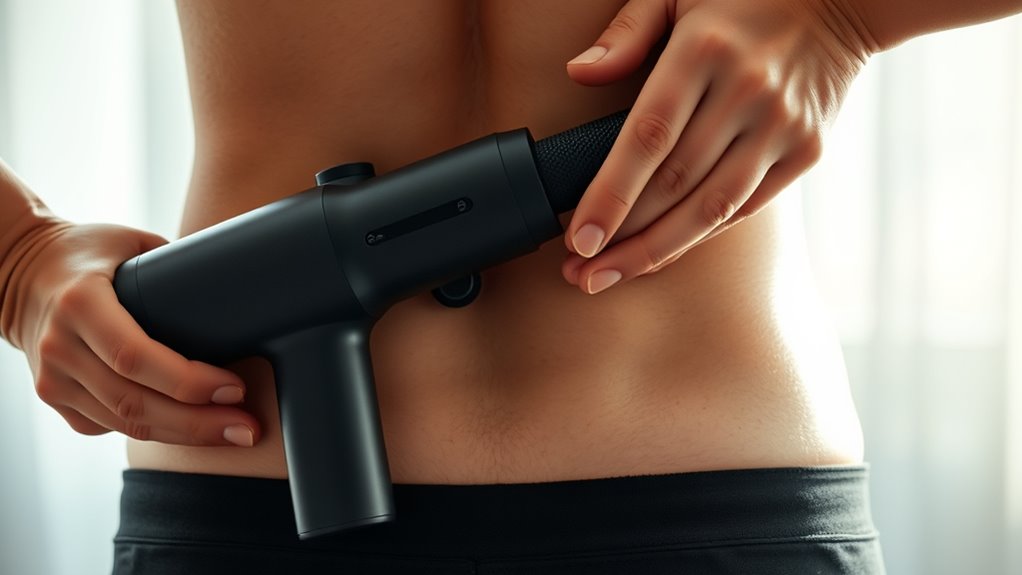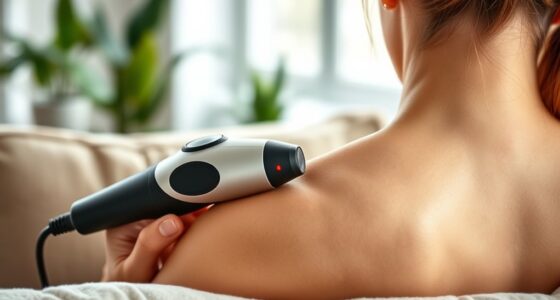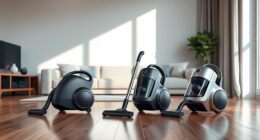To use massage guns for sciatica safely, start with gentle pressure to understand your body’s response. Focus on large muscle groups like your glutes, hips, and lower back, avoiding sensitive or inflamed spots. Don’t press directly on the sciatic nerve or linger too long on any area. Keep the device at moderate speed and pressure to prevent irritation. For detailed tips on safe techniques, explore further guidance to help manage your symptoms effectively.
Key Takeaways
- Start with gentle pressure and low speed to assess your body’s response before increasing intensity.
- Focus on large muscle groups like glutes, hamstrings, and lower back, avoiding direct contact with the sciatic nerve.
- Avoid applying excessive force or lingering on tender or inflamed areas to prevent nerve irritation.
- Use slow, deliberate movements and avoid rapid, aggressive strokes to reduce the risk of nerve flare-ups.
- Combine massage with other recovery strategies, such as proper air quality and stretching, to support safe sciatic relief.

If you’re struggling with sciatic nerve pain, you might find relief using a massage gun. These devices can target tight muscles and help reduce discomfort, but it’s crucial to use them correctly to avoid aggravating your condition. One key aspect is understanding trigger points—small, hyperirritable spots within a muscle that can refer pain along the sciatic nerve. When these trigger points are active, they contribute to muscle tension, which can worsen sciatic symptoms. Using a massage gun on these areas can help release muscle tension and diminish trigger point activity, but you must be cautious.
Start by identifying areas of tightness or soreness around your lower back, hips, and buttocks. These are common zones where trigger points develop and contribute to sciatic pain. When you use the massage gun, apply gentle pressure initially to see how your body responds. Moving the device slowly over muscle groups can help release knots and reduce muscle tension without causing discomfort. Avoid pressing directly on the sciatic nerve or inflamed areas, as this can trigger nerve pain flares.
It’s important to keep the massage gun at a moderate speed and pressure, especially if you’re new to using it. Too much force or prolonged application on sensitive areas might cause more inflammation rather than relief. Focus on large, muscle-rich areas like your hamstrings, glutes, and lower back, rather than small or tender spots. These larger muscles often harbor trigger points and muscle tension that contribute to sciatic nerve irritation. Additionally, using HEPA filtration devices to improve overall air quality can help reduce inflammation and promote faster recovery. By systematically working through these areas, you can promote better blood flow, relax tight muscles, and minimize nerve pressure.
Frequently Asked Questions
Can Massage Guns Replace Physical Therapy for Sciatica?
You shouldn’t see a massage gun as a replacement for physical therapy when dealing with sciatica. While massage gun efficiency can provide relief from muscle tension, it isn’t a thorough solution. Physical therapy offers targeted exercises, professional guidance, and addressing underlying issues, making it a more effective treatment. For best results, consider massage guns as a complementary physical therapy alternative, but always consult your healthcare provider for personalized advice.
How Often Should I Use a Massage Gun for Sciatic Pain?
Imagine turning your sciatic pain into a full-time job—hope you like your new boss, discomfort! For safe usage, follow the frequency guidelines: limit sessions to 10-15 minutes, 2-3 times a week. Overdoing it can turn relief into a nerve flare. Always listen to your body, and if pain worsens, cut back or consult a pro. Remember, moderation keeps your sciatic boss happy!
Are There Specific Massage Gun Attachments Best for Sciatica?
When choosing attachment options for sciatica, opt for softer, round heads that gently target the affected area without causing discomfort. Adjust the pressure settings to a low or moderate level, ensuring you don’t apply too much force. You should start with light pressure and gradually increase if needed. Always listen to your body and stop if you experience any pain or nerve flare-ups, prioritizing comfort and safety.
Can Massage Guns Cause Long-Term Nerve Damage?
It’s unlikely that using a massage gun causes long-term nerve damage, especially if you’re mindful of nerve sensitivity. Coincidentally, overuse or applying excessive pressure might lead to tissue damage or nerve irritation temporarily. To protect yourself, always follow recommended guidelines, avoid aggressive settings, and listen to your body. If you notice persistent pain or numbness, stop use and consult a healthcare professional. Proper technique minimizes risks and keeps your nerves safe.
Is It Safe to Use a Massage Gun During a Sciatic Flare-Up?
Using a massage gun during a sciatic flare-up can sometimes worsen nerve irritation if applied incorrectly. It’s best to avoid direct pressure on the sciatic nerve and focus on muscle relaxation around the affected area. Always listen to your body, start with gentle settings, and consult a healthcare professional if you’re unsure. Proper use helps relax muscles without aggravating nerve pain or causing further irritation.
Conclusion
Using a massage gun can provide relief from sciatic nerve discomfort if used correctly. Just remember, over 80% of people experience some form of nerve pain at least once, so taking precautions is essential. Always start gently, avoid sensitive areas, and listen to your body. When used properly, a massage gun can be a helpful tool in managing your sciatic symptoms and preventing flare-ups. Stay mindful, and you’ll enjoy safer, more effective relief.









